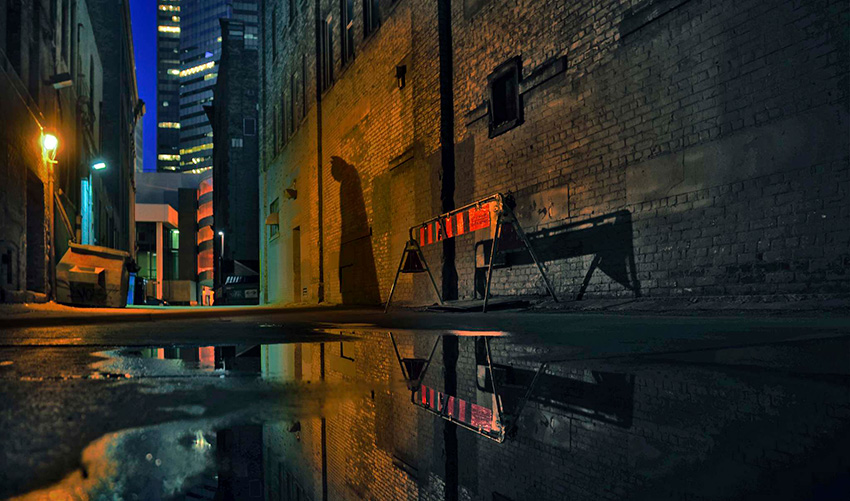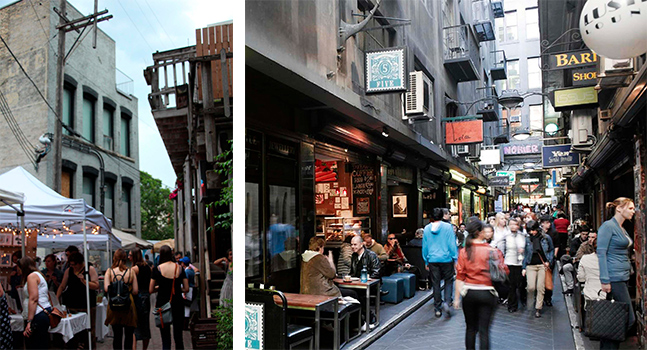
By Brent Bellamy, Creative Director and Architect
Republished with permission courtesy of the Winnipeg Free Press.
Developing alleys could breathe new life into the city
The back lane was a perfect spot to play street hockey when we were kids. The narrow alley was enclosed and protected, houses were close-set, allowing our parents to maintain a watchful eye. The occasional slow-moving vehicle could be accommodated simply with an enthusiastic howl of ‘car!’ Image: (Supplied / Winnipeg Free Press) The silhouette of Batman adorns a downtown alleyway. Public art such as graffiti gives alleyways their unique, urban character.
Image: (Supplied / Winnipeg Free Press) The silhouette of Batman adorns a downtown alleyway. Public art such as graffiti gives alleyways their unique, urban character.
The intimacy and human scale that makes residential alleys so great for street hockey are characteristics shared with the narrow urban lanes found throughout many downtown areas. These attractive qualities are leading cities around the world to explore the potential of re-engaging these forgotten urban connectors.
Streets with a similar personal scale inspire the vibrant sidewalk culture that makes European city centres an attractive vacation destination for so many, but in our downtown we demand wide, straight roadways designed primarily to funnel cars as quickly as possible into the suburbs. Any efforts to narrow these thoroughfares and improve the pedestrian experience are often met with strong opposition. Image: Kristin Pauls (left)
Image: Kristin Pauls (left)
A pop-up market in the East Exchange District this summer attracted large crowds.
Image: Tourism Australia (right)
Opening Melbourne’s alleys added a new dimension to urban living in the Australian city.
The city’s back lanes, however, might provide an opportunity to efficiently create this welcoming pedestrian environment within existing infrastructure. These narrow, enclosed spaces, generally used for loading and garbage collection, are being reimagined in many cities as an alternate pedestrian network superimposed on the larger street grid, introducing lively, people-first, public space.
The city that pioneered reclaiming downtown laneways is Melbourne, Australia. In the early 1980s, that city’s downtown was a homogeneous business centre with fewer than 2,000 residents, two outdoor sidewalk patios and 300 metres of active laneways. To breathe life back into downtown, the city developed a strategy to increase the residential population to 10,000 in 15 years. Investments were made in initiatives that would make urban living more attractive. They focused on improving the pedestrian experience by widening sidewalks, planting trees, creating green space and redeveloping their dormant urban laneways.
The design approach was to consider the lanes as a cohesive secondary network that would provide pedestrian mobility and connectivity throughout the downtown. Lanes were either shared with low-volume vehicle traffic or made pedestrian-only, with deliveries and building servicing co-ordinated at off hours.
Alleys were named to help create an identity, and physical improvements were made. New paving, awnings, plants, street furniture and lighting were installed.
The improvements carefully retained the gritty, industrial quality of the alleys, preserving the underworld character that provides an enticing and unique experience from other urban environments. Many walls were left adorned with graffiti, and a program of continually evolving public art was established to make each alley a unique gallery of artistic expression.
Most importantly, local businesses were encouraged through financial incentives, promotion and policy change to locate in new storefronts created along the alleyways.
Small spaces were carved into the ground floors of existing buildings, creating new revenue opportunities for owners and encouraging low-rent startups and small business opportunities.
The result has been transformational for Melbourne. The intimate and sheltered qualities of the back lane network provide a finer grain to the city, breaking it down to a personal scale. Like European medieval cities, the narrow lanes, today lined with eateries, bars and boutiques, connect people to each other in a safe and stimulating environment, filled with rich sensory experiences. The attraction of these new public spaces has made downtown Melbourne a desirable place to live, inspiring significant residential development, many with entrances to the laneways. New buildings often incorporate arcades and alleys within their plan to connect to the success of the existing network.
Melbourne’s city centre has far surpassed its urban-renewal goals, today home to more than 100,000 people, 500 outdoor patios and 3.5 kilometres of animated lanes. The city now consistently appears at the top of global quality-of-life rankings.
The success of rediscovering urban laneways in Australia is enticing cities in New Zealand, California and even Vancouver and Toronto to begin studying and implementing similar initiatives.
Winnipeg’s downtown, which lacks human scale in many areas, would seem to be an ideal candidate for such a transformation. The central lanes dividing the oversized blocks south of Portage Avenue were once an important secondary pedestrian grid, before density was replaced with parking lots. In the Exchange District, lanes and covered passageways are still commonly used as pedestrian connections throughout the neighbourhood.
Awareness for the potential of our downtown laneways has been growing. A number of recent festivals have held parties and pop-up design installations in the alleys of the Exchange District. The Downtown Winnipeg BIZ is currently working through an international design competition called the Backlane Public Art Project for the space behind Mountain Equipment Co-op on Portage Avenue. The winning scheme will be announced and installed this fall. A series of evening outdoor markets has also been happening in various Exchange District alleys this summer (www.alleywaysmarket.ca) to bring attention to these underused spaces.
These events coincide with the construction start of a back lane development project for John Hirsch Place, a former rail spur running behind the buildings on Bannatyne Avenue near Waterfront Drive. Designed by HTFC Planning and Design, the lane will be transformed into Winnipeg’s first Woonerf, a Dutch term meaning ‘living street’, where cars, pedestrians and cyclists all share public space without physical separation. A perfect place for a game of street hockey.
The lane will be curb-less, with large paving stones running in a dynamic geometric pattern from building edge to building edge. These will be supported on an innovative series of underground storage cells that control stormwater and provide trees with ample soil volumes to ensure they grow healthy and large. Planters, public art and seating will be positioned to slow vehicular traffic to walking speed and make the alleyway a beautiful green finger extending from the riverbank into the Exchange District. The hope is one day shops or restaurants might open into the lane to further activate the space.
This progressive laneway initiative will stand as an example of what these intimate hidden spaces can become and will hopefully be the catalyst for a larger network of active laneways winding through the city centre.
The future health of downtown Winnipeg depends on our ability to create safe, vibrant, walkable neighbourhoods with the interest and amenities that make urban living attractive. Simply subsidizing the construction of residential units will be a lost investment if we don’t also build the conditions that make people want to choose to live downtown.
Increasing active public space is crucial to achieving this, but in low-density cities such as Winnipeg, it must be appropriately scaled. Smaller, far-reaching laneway redevelopment that weaves through the disconnected neighbourhoods of downtown would likely find more success than large plazas and green spaces that often remain empty and under-used.
Forward-looking initiatives like the John Hirsch Place redevelopment are a starting point for looking at urban renewal in a new way, taking advantage of downtown’s natural assets to create intimate, pedestrian-focused public space that provides unique experiences not found in the suburbs. With the success of Melbourne in mind, envisioning an active web of green laneways spread through the downtown is a tantalizing image for the future of our city.
Brent Bellamy is creative director at Number Ten Architectural Group.
bbellamy@numberten.com

